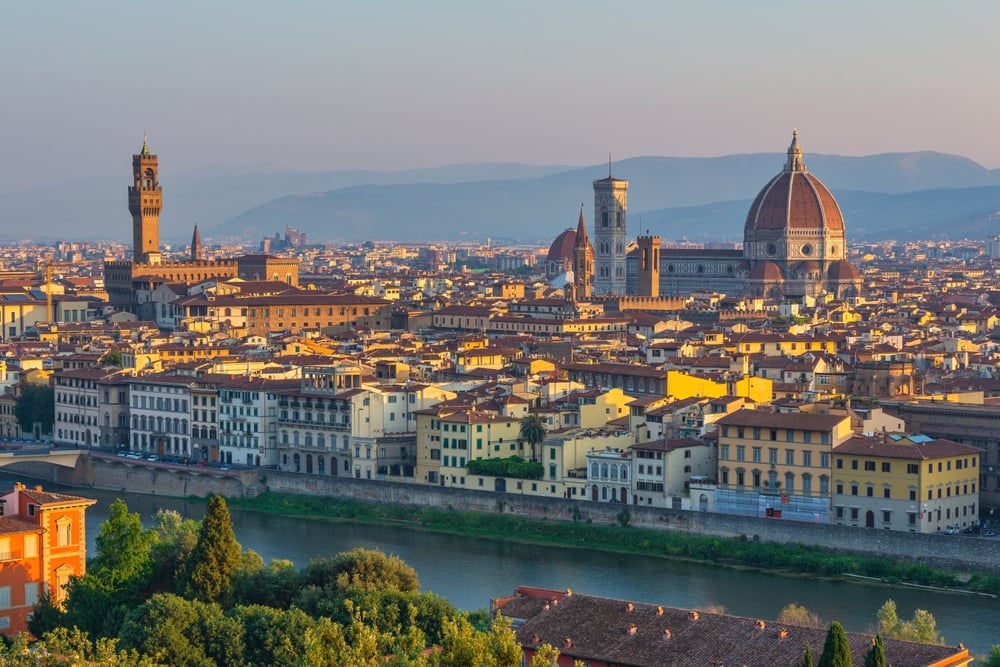Florence is the capital of Tuscany and the birthplace of the Italian Renaissance. The city skyline is dominated by its famous Duomo, the Cathedral of Santa Maria del Fiore. It is home to Michelangelo’s David statue in the Galleria dell’Accademia di Firenze and Botticelli’s “Birth of Venus” and “Primavera” at the Uffizi Galleries. Wander through the city’s charming, walkable streets and admire the Arno River while walking across Ponte Vecchio.
You know I already love helping you make the most of your European cruise stops, and now, it’s finally Italy’s turn! If you are visiting Florence on a cruise, I’ve got your ultimate guide to seeing all the must-see attractions and landmarks in one action-packed day. Florence is a compact city, perfectly suited for exploring on foot. You can easily stroll from one iconic landmark to the next, so you won’t need to worry about navigating public transportation.
Remember: The times listed here are approximate. Your schedule might be different, as you’ll need to account for docking, travel to Florence, and your “all aboard” time.
How Do I Get To Florence From My Cruise Port?
If you are visiting Florence on a cruise, you will see that your cruise port is probably either the port city of Livorno or the port city of La Spezia. On my cruise, the ship docked in Livorno. It is very straightforward to take the train from either of these two port cities to get to Florence. However, it takes around 35 minutes longer to get to Florence from La Spezia than from Livorno by train.
You can book your train tickets on Trainline, which is exactly how I booked train tickets to Florence from the Livorno station; I talk more about using Trainline in my essential travel apps post. The Florence train station you want as your destination is the Florence Santa Maria Novella station, not Firenze Rifredi or Firenze Campo di Marte. As Florence’s main and largest station, Santa Maria Novella offers the widest selection of trains and departure times.
The two main train companies that will take you to Florence from Livorno or La Spezia are Trenitalia and Italo. Trenitalia is the national railway operator that runs the majority of trains in Italy, while Italo is a private high-speed rail company. Trenitalia, as the state-owned rail company, often offers competitive pricing, especially for regional routes, and if tickets are booked in advance (I booked tickets on Trenitalia).
Morning: Churches & Cathedrals
Basilica di Santa Croce:
9:30am-10am
Start your day by visiting the Basilica di Santa Croce (Basilica of the Holy Cross). I suggest getting to the Basilica when it opens at 9:30am for visitors on Monday through Saturday (it is closed on Sundays),. This way, you’ll avoid the lines and maximize your total time in the city. This famous Basilica is a Franciscan church and has Neo-Gothic architecture, built between 1294 and 1442. It has sixteen chapels, many of which were commissioned and decorated by wealthy Florentine families.
Santa Croce is most famous for being the final resting place or a memorial for many of Italy’s most celebrated historical figures, including Michelangelo, the renowned sculptor, painter, and architect; Galileo Galilei, the astronomer and physicist; and Niccolò Machiavelli, the influential political philosopher and writer.
You can buy tickets online here at their official website or at the ticket office to do a self-guided tour. Tickets cost €10 per person; tickets are free for children 11 and under. I don’t recommend booking a guided tour for the Basilica; since you only have one day in Florence, it would take up too much time.
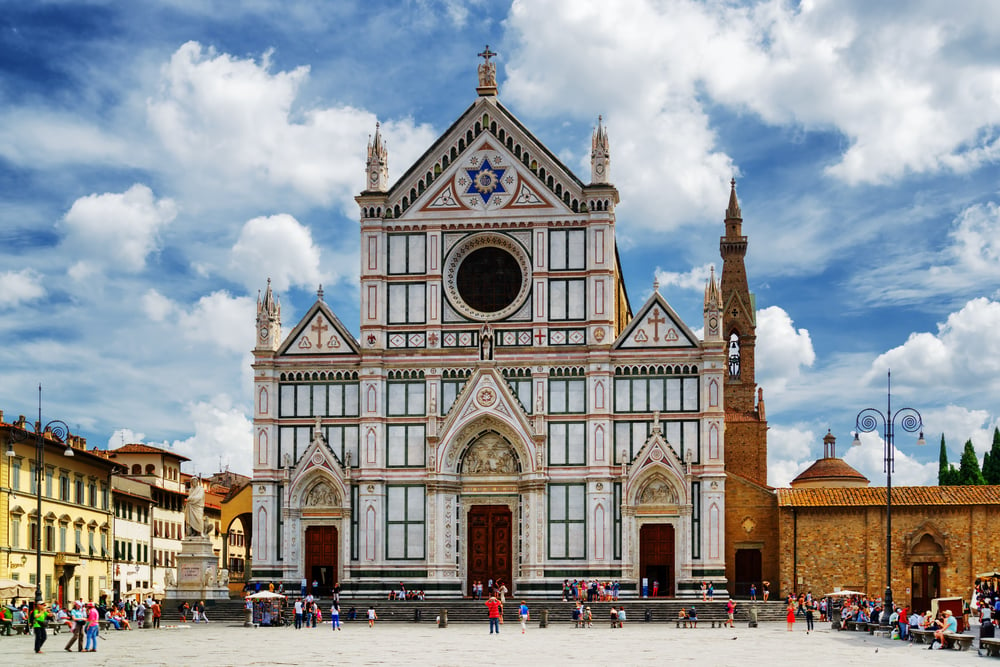
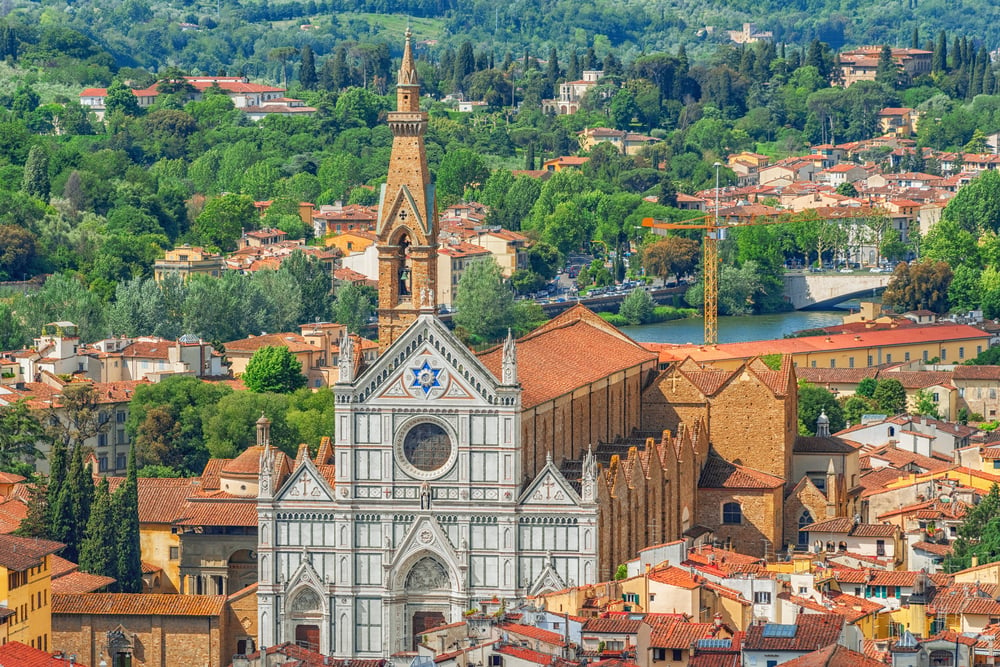
Cathedral of Santa Maria del Fiore (Duomo) and Museum:
10:15am-12:15pm
How to get here: It takes 10 minutes to walk from the Basilica to the Duomo. Walk through the Piazza di Santa Croce toward Via dell’Anguillara and make a right onto Via dell’Anguillara. Continue walking onto Via della Condotta and make a right onto Via dei Calzaiuoli. You will see the cathedral on your right.
The Cathedral of Santa Maria del Fiore is the highlight of Florence, a breathtaking masterpiece of Gothic and Renaissance architecture. Its dome is the largest masonry dome ever built. Visitors are allowed to go inside the cathedral for free, but there will likely be a long line, especially in summer.
To maximize your time, I suggest skipping the lines for the interior and dome climb, as both can take up a significant portion of your day. Instead, I recommend visiting the Opera del Duomo Museum (Museo dell’Opera del Duomo), just east of the cathedral. The museum showcases many of the cathedral’s original artworks and is acclaimed as “one of the world’s most important collections of sculpture,” as noted by author Rolf C. Wirtz. You can see both the Opera del Duomo Museum and Giotto’s Bell Tower (what you will see next) with one ticket, which you can purchase on the official website.
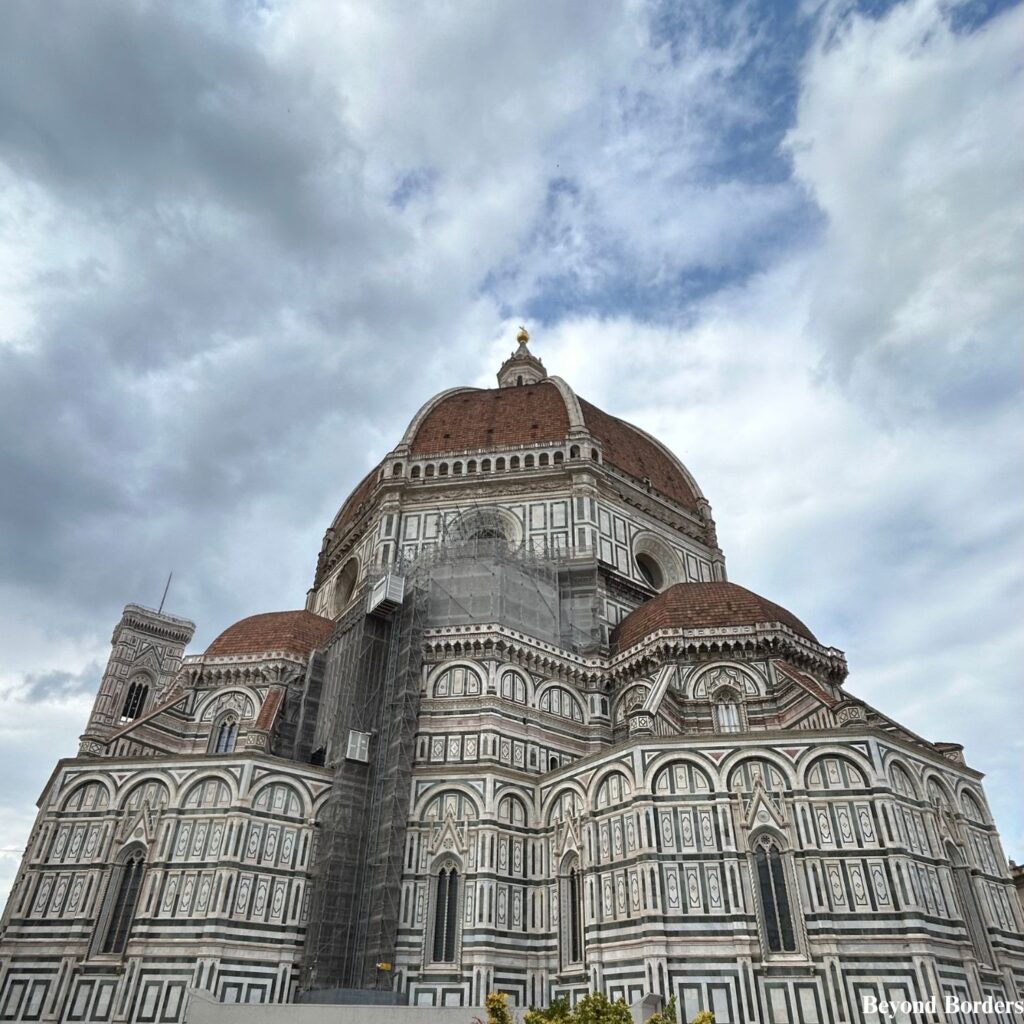
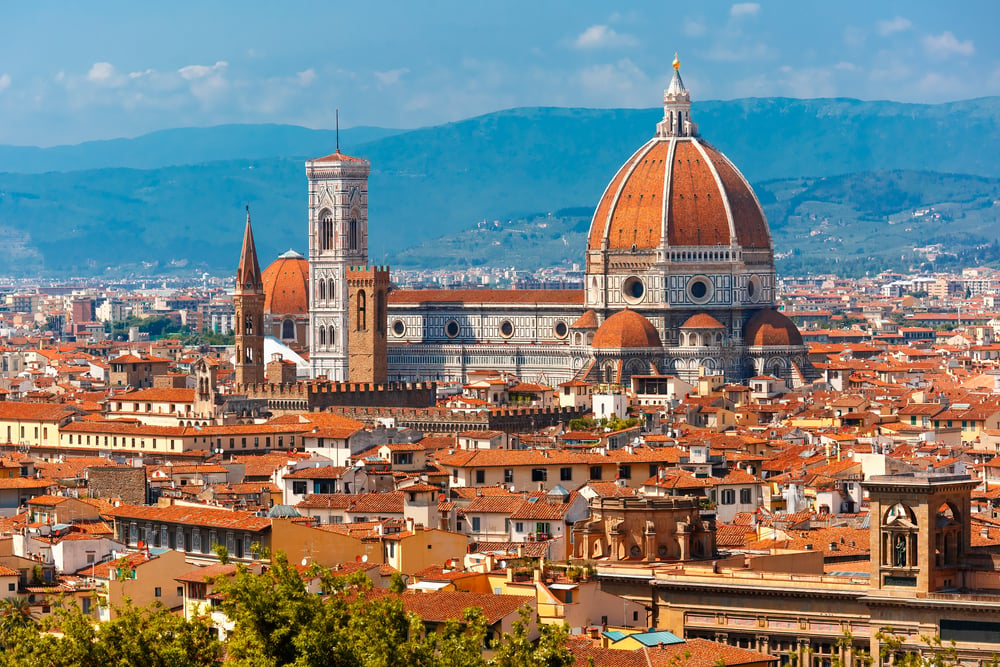
Afternoon: Stunning Views, Lunch, and Exquisite Art
Giotto’s Bell Tower: 12:30-1:15pm
The extra activity I highly recommend doing during your visit to the Duomo is going up Giotto’s Bell Tower (also known as Giotto’s Campanile). This is an exquisite freestanding bell tower that stands beside the cathedral. It is considered one of the most beautiful bell towers in Italy and a quintessential example of Florentine Gothic architecture.
The top of the bell tower offers breathtaking 360-degree panoramic views of Florence! From here, you get an unparalleled perspective of the cathedral’s dome, the city’s terracotta rooftops, the Arno River, and the Tuscan hills surrounding the city. Note: The ascent consists of walking up 414 steps, and the recommended duration for the visit is approximately 45 minutes. Tickets cost €20 per adult, €7 per child ages 7-14, and those 6 and under go free.
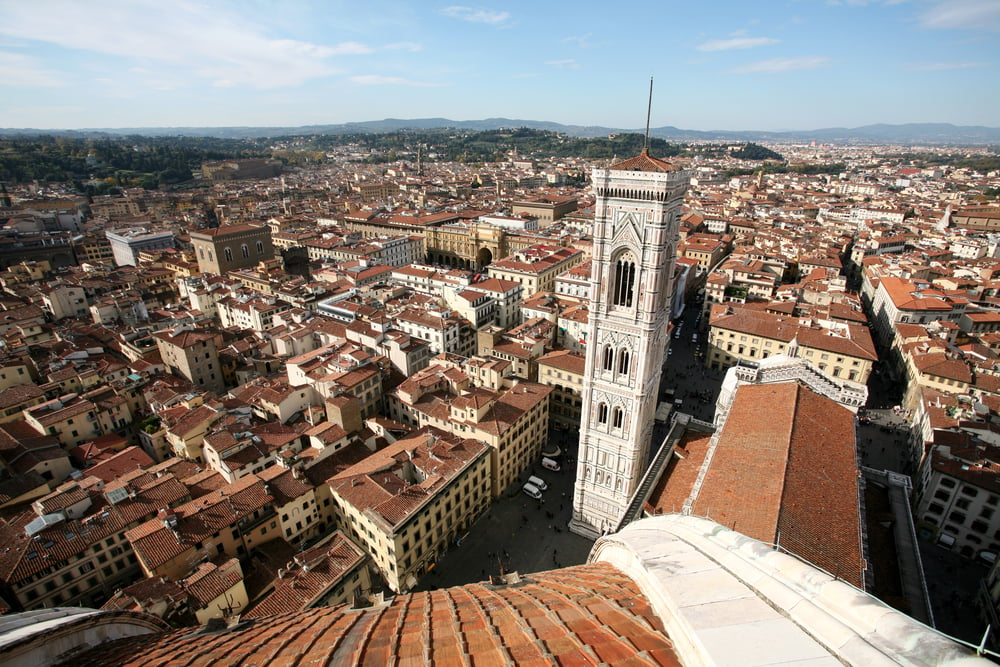
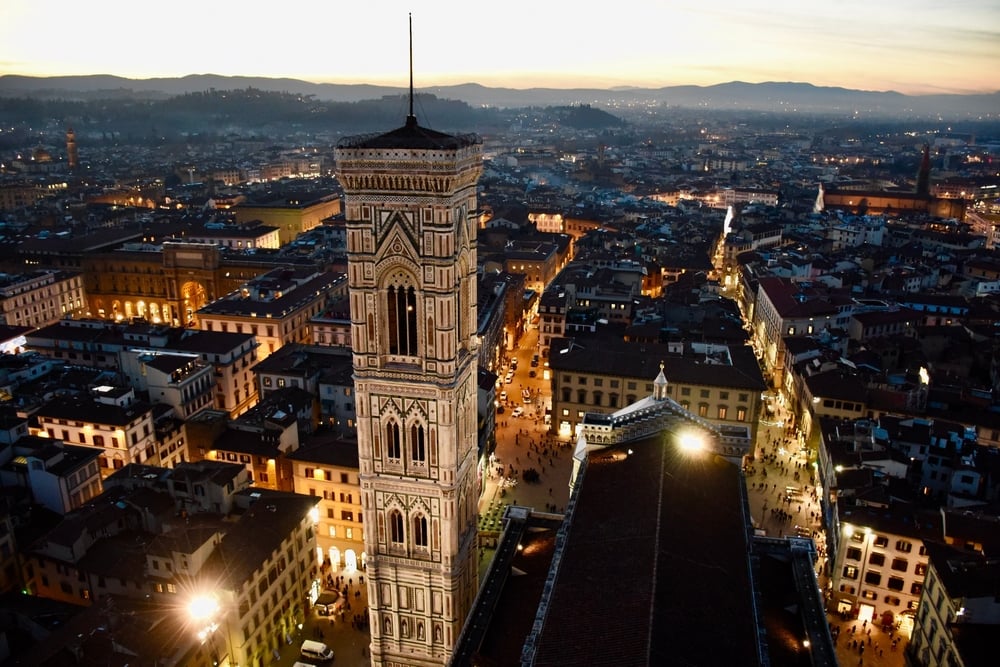
Lunch at All’Antico Vinaio and Gelato:
1:30-2:30pm
How to get here: It takes just under 10 minutes to walk to All’Antico Vinaio from the bell tower. Head towards Piazza del Duomo and make a left onto Via dei Calzaiuoli. You’ll pass the Piazza della Signoria and make a right onto Via Vacchereccia. Make a left onto Via della Ninna, and continue straight onto Piazza del Grano. Cross Via dei Leoni onto Via dei Neri. You’ll see the sandwich shop on your left.
Arguably the most famous place to eat in Florence is All’Antico Vinaio, located on Via dei Neri. All’Antico Vinaio is renowned for its schiacciata, a flat, airy, and slightly salty Tuscan bread that’s crisp on the outside and soft on the inside. They also use high-quality, fresh Tuscan ingredients. Moreover, each sandwich is generously sized and can be shared. Of course, due to the sandwich shop’s fame, there is an inevitable, yet surprisingly fast-moving, line. Despite the wait, the staff are incredibly efficient at making the line move fast. I only had to wait about 15 minutes, even though the line was out the door onto the street!
After getting your sandwich, get some gelato. I recommend going to Gelateria dei Neri, right down the street. Other popular gelato options include Gelateria La Carraia (right next to the Ponte alla Carraia across the Arno River), and Cantina del Gelato Il Gelato Artigianale (across the Arno River from the Uffizi Galleries).
Choose: Galleria dell’Accademia di Firenze or Uffizi Galleries:
3:00-4:30pm
How to get to the Galleria dell’Accademia: It takes 15 minutes to walk to the museum. Make a right onto Via dei Leoni and walk straight onto Via del Proconsolo. Continue walking straight onto Piazza del Duomo. Then, make a right onto Via dei Servi and a left onto Via de’ Pucci. Make a right onto Via Ricasoli and the museum will be on your right.
How to get to Uffizi Galleries: Cross Via dei Leoni and walk onto Via della Ninna. Then make a left onto Piazzale degli Uffizi and you will see the museum.
After lunch, visit either the Galleria dell’Accademia di Firenze or the Uffizi Galleries. The Galleria dell’Accademia is a small art museum, most famous for being the home of Michelangelo’s David sculpture, made between 1501 and 1504. While David is the main draw to this museum, there is more to see: it showcases several other significant works by Michelangelo, including his “Prisoners” or “Slaves”, a series of four unfinished male nude sculptures intended for the tomb of Pope Julius II.
The museum also has a substantial collection of Florentine paintings from the 13th to the 16th centuries, particularly a prestigious selection of gold-ground panel paintings. A lesser-known part of the museum is its Museum of Musical Instruments, which has rare and valuable instruments.
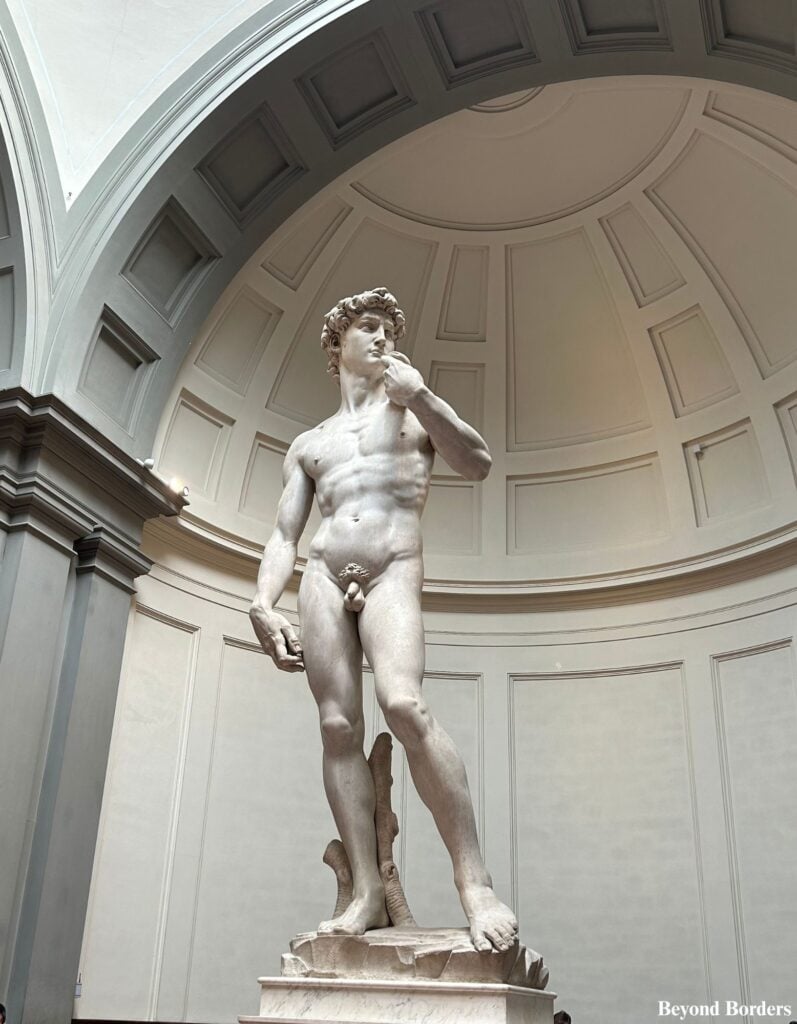
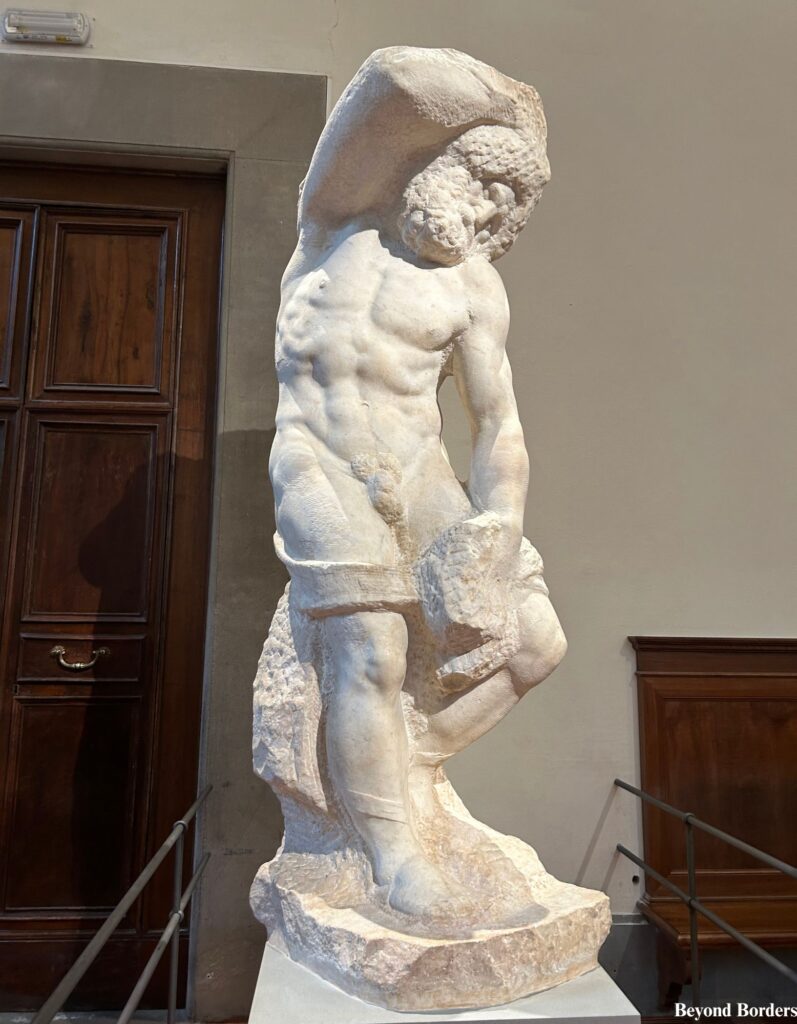
The Uffizi Galleries is one of the oldest and most famous art museums in the world, home to Italian Renaissance masterpieces. Visitors walk through rooms arranged chronologically, tracing the evolution of art from the late Middle Ages through the High Renaissance and beyond. Highlights for many visitors are the works of Sandro Botticelli, including his “Birth of Venus” and “Primavera” (Spring) paintings. These masterpieces are instantly recognizable and illustrate the grace and beauty of the early Renaissance. Additionally, the museum has Leonardo da Vinci’s early masterpiece, “Annunciation,” and his “Adoration of the Magi” (left unfinished), and Michelangelo’s only panel painting, the vibrant “Doni Tondo” (Holy Family). Lastly, found here are ancient Roman sculptures and busts.
Choose to visit whichever museum interests you the most. I did a tour of the Galleria dell’Accademia, which was only a little over an hour long. Tours of the Uffizi Galleries are around 1.5 hours long on Viator and GetYourGuide, so time shouldn’t be a factor in choosing which museum to visit. I strongly advise booking a “skip-the-line tour” of either museum. Even during my September visit, which is typically considered shoulder season, the wait times to get in were still extensive, so I was glad I was on a skip-the-line tour. If you do not want to book a guided tour, make sure to purchase tickets on the official website of the Galleria dell’Accademia or the official website of the Uffizi Galleries well in advance.
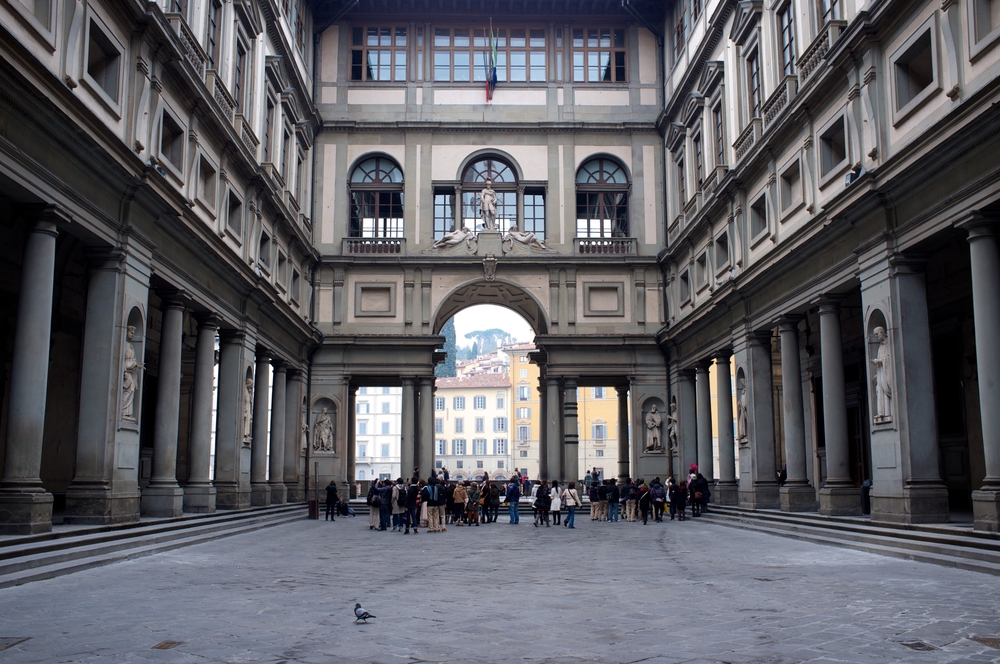
Evening: Historic Piazza
Piazza della Signoria:
4:45-5:45pm
How to get here from the Galleria dell’Accademia: It takes 10 minutes to get to the piazza from the Galleria. Walk on Via Ricasoli toward Piazza delle Belle Arti, and stay on Via Ricasoli. Then, make a right onto Piazza del Duomo and then a left onto Via dei Calzaiuoli. Continue walking and you will see the piazza.
How to get here from the Uffizi Galleries: The piazza is right across from the Uffizi Galleries, so you should see it when leaving the museum.
After visiting the art museum you chose, walk to the Piazza della Signoria to relax and take photos. This large plaza has been central to the city’s public life for centuries and is also known as an open-air art gallery, showcasing several sculptures worth seeing, such as several David replicas, as well as the Fountain of Neptune. To the right of the Palazzo Vecchio, the Loggia dei Lanzi is a 14th-century open-arched loggia housing a collection of impressive Renaissance and Mannerist sculptures.
The Palazzo Vecchio was (and sometimes still is) Florence’s city hall, serving as the seat of political power for the Florentine Republic and later the Medici dukes. Visitors can explore its grand halls, including the massive Salone dei Cinquecento (Hall of the Five Hundred), the largest room in the Palazzo Vecchio. Feel free to step inside and admire the building. Overall, the Piazza della Signoria is a vibrant public space, constantly filled with tourists admiring the art, street performers entertaining crowds, and locals passing through.
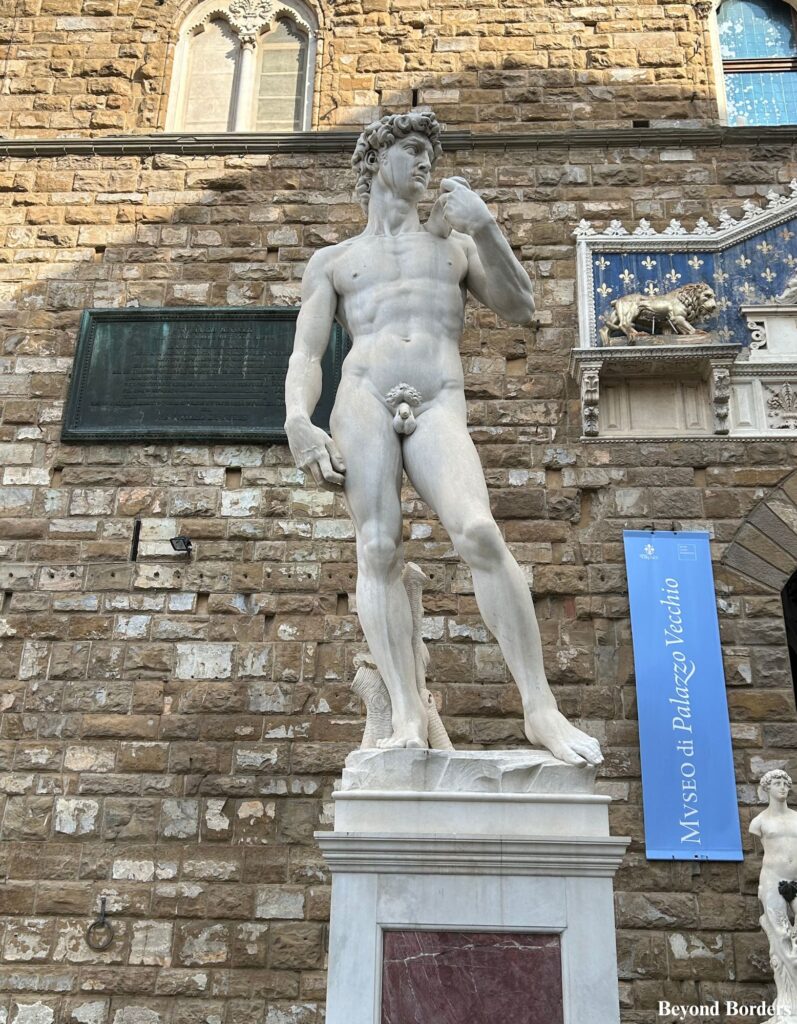
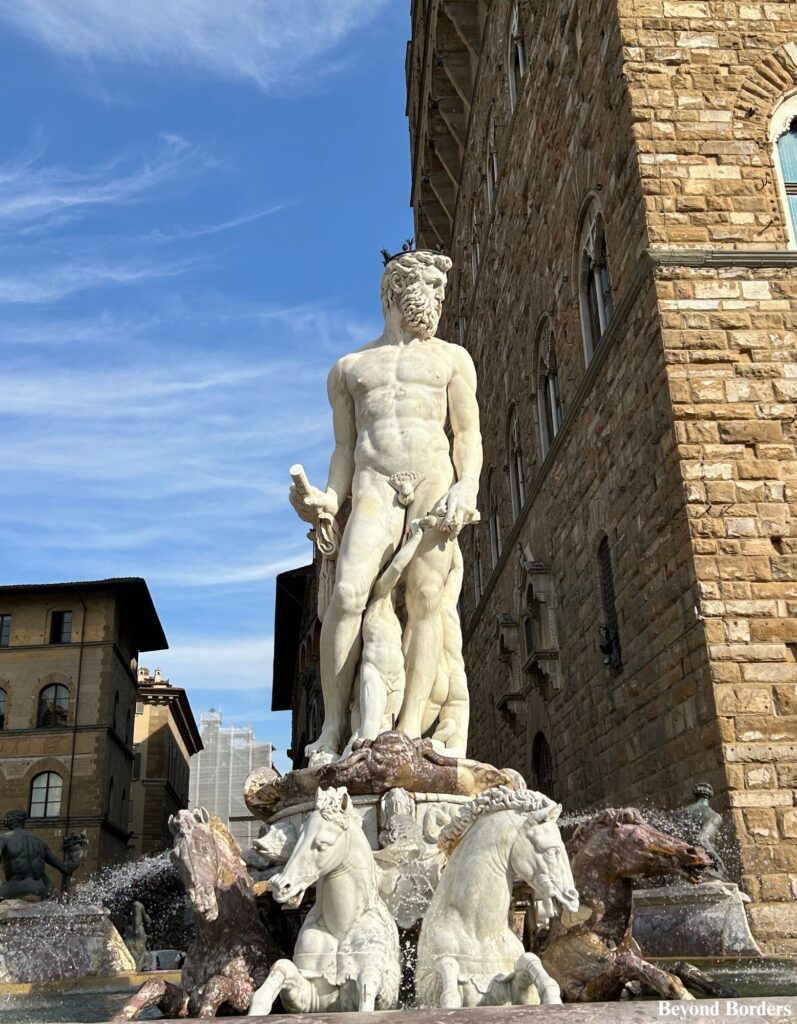
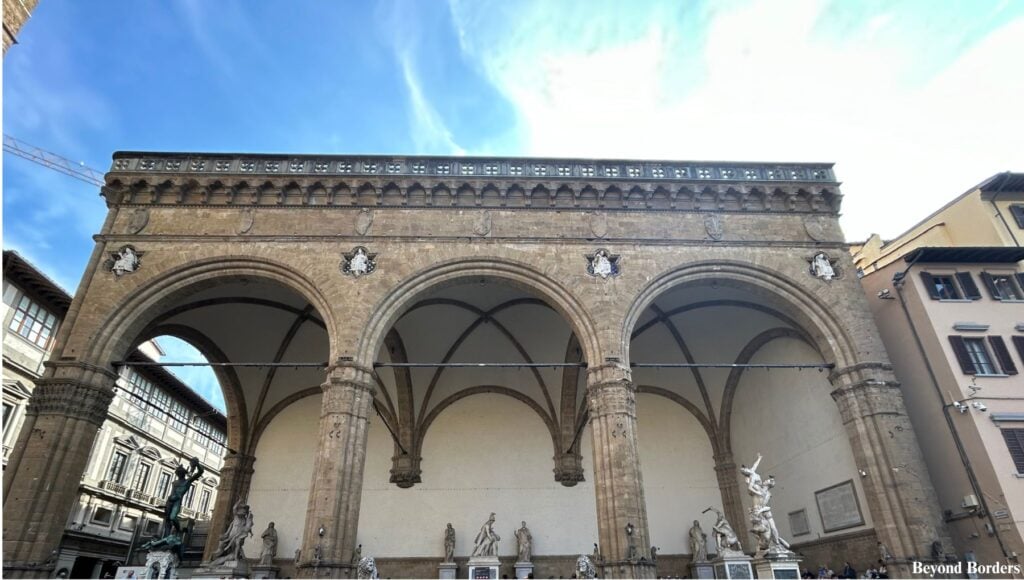
Head Back to Your Ship
As the sun begins to set on your unforgettable day in Florence, it’s time to head back to the ship. You’ve packed a lifetime of art, history, and beauty into just a few hours. Make your way back to the Firenze Santa Maria Novella train station and catch your return train to the port, ensuring you leave with plenty of time to spare. A single day may not be enough to see everything Florence has to offer, but I hope it has given you a taste of its magic and left you dreaming of a return visit!
Additional Option: Ponte Vecchio:
5:50-6:45pm
How to get here: Walk onto Via Vacchereccia, then make a left onto Via Por Santa Maria, and you will see the bridge.
Depending on your “all aboard time,” you may have time to visit one more attraction before you have to head back to your ship. If you have the time, I recommend walking across the Arno River on Ponte Vecchio. Ponte Vecchio is the most famous and iconic bridge in Florence! This medieval arched bridge is the oldest crossing of the Arno River in the city. Its history dates back to Roman times, with the current bridge being rebuilt in 1345 after a flood. This makes it one of the oldest stone bridges in Europe.
Ponte Vecchio was the only bridge in Florence that the Germans did not destroy during World War II, supposedly due to a direct order from Hitler himself, who admired its beauty. The bridge is famously lined with jewelry & souvenir shops. This was once a common practice on bridges, but the Ponte Vecchio is one of the very few to continue this custom. Alongside the Cathedral of Santa Maria del Fiore, Ponte Vecchio is one of the most recognizable and photographed landmarks of Florence.
Spend some time walking and shopping along the bridge before grabbing dinner.
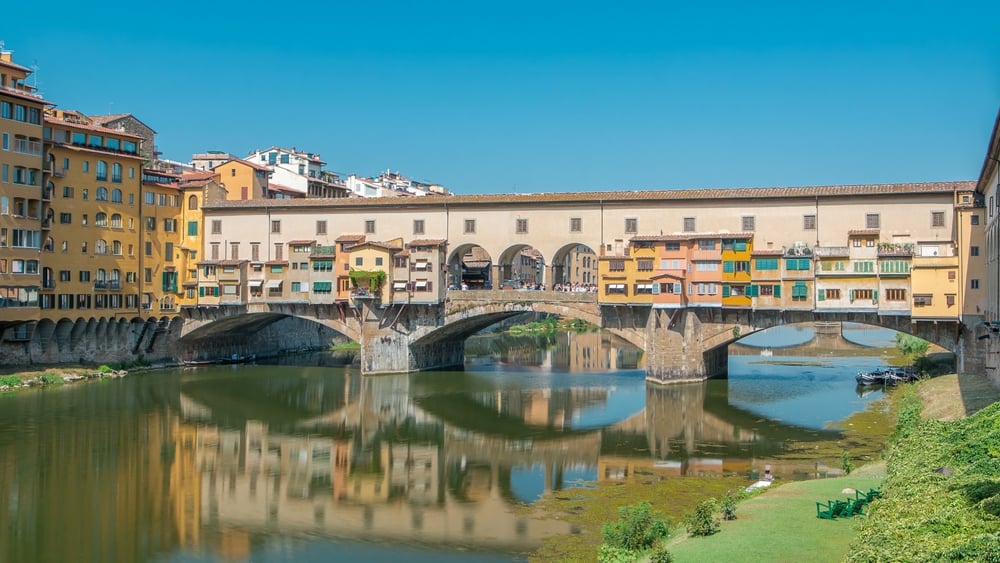
Additional Option: Dinner
If you have the time to stay in Florence for dinner, a popular restaurant amongst locals and tourists is Trattoria Dall’Oste. This is a famous steakhouse located only a 2-minute walk from the Duomo. If you want to eat here, make a reservation in advance! The restaurant has a line outside during dinnertime. Guests love the Florentine steak. Check out the menu here.
Another restaurant I recommend is Vini e Vecchi Sapori, a small, family-run osteria next to the Piazza della Signoria. This restaurant serves traditional Tuscan dishes. Make a reservation in advance if you would like to eat here! Note: Reservations are accepted by phone only, and the restaurant is closed on Sundays.
Conclusions
After a whirlwind day of exploring Florence, you can officially say you’ve conquered its highlights! While a single day offers only a glimpse, it’s a perfect taste of the city’s timeless art and history. I hope this itinerary helped you make the most of your limited time and has inspired you to return one day for a longer, more leisurely stay.
More Tips
More Food Recommendations
- New Bridge Pizza Club
- Osteria Vecchio Cancello
- Trattoria Giovanni
- Rooster Cafe Firenze—Sant’Egidio: brunch restaurant
- Lunetta Café: breakfast restaurant
Gelato Recommendations
- Vivoli
- La Strega Nocciola Gelateria Artigianale – Firenze Duomo
- Edoardo il Gelato Biologico – Gelateria Piazza Duomo
- RivaReno Gelato Firenze
- Sbrino – Gelatificio Contadino

